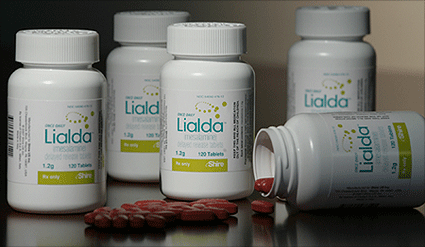Product
Lialda
Approval Date
January 16, 2007
Release Date
February 21, 2007
Company
Shire
Class
Aminosalicylate
Indication
To induce remission in active, mild-to-moderate ulcerative colitis.
Active Ingredient
Mesalamine 1.2g; del-rel tabs.
Agency Roster
Euro RSCG Life Chelsea (Consumer and Professional)
Marketing Strategy/Execution
As the only FDA-approved, once-daily oral formulation of mesalamine, Lialda looks positioned to generate strong sales in ulcerative colitis. The product also may benefit from some off-label use in Crohn’s disease, general bowel infection and abdominal pain, according to Datamonitor, which predicts overall brand sales at $330 million in 2015. Shire already markets mesalamine-containing Pentasa, but analysts don’t expect Lialda to cannibalize sales of the older drug. Other Shire launches this year (Elaprase for Hunter syndrome and Dynepo for anemia) may stretch the company’s marketing resources.
The Market
| GI anti-inflammatory US sales ($000s) last 5 years | |
| 2006 |
3,580,949 |
| 2005 |
3,130,582 |
| 2004 |
2,790,409 |
| 2003 |
2,394,831 |
| 2002 |
1,971,406 |
| Source: IMS Health, Oct. 2007 |
|
| Top 5 GI anti-inflammatory | ||
| Jan.-July ’07 US sales ($000s) | % sales growth over Jan.-July ‘06 | |
| REMICADE (Centocor) |
1,578,794 |
10 |
| ASACOL (Procter & Gamble) |
323,519 |
10 |
| PENTASA (Shire) |
91,727 |
10 |
| COLAZAL (Salix) |
75,797 |
10 |
| ENTOCORT EC (Prometheus) |
65,098 |
37 |
| Source: IMS Health, Oct. 2007 |
||
Physician Outlook
According to our research, 70% of gastroenterologists anticipate increasing their use of Lialda for the treatment of ulcerative colitis in the next six months, citing its mechanism of action, immune system support, lower toxicity and lower pill burden. Although Lialda is not yet approved for Crohn’s disease, half of gastroenterologists anticipate near-term increases in its usage to treat this disease.
—Mary McBride, associate VP, GfK Market Measures, October 2007
Also in the Pipeline (according to Adis R&D Insight)
Drug: Orencia/ CTLA4
Manufacturer: Bristol-Myers Squibb
Indication: Juvenile rheumatoid arthritis, Crohn’s disease, Ulcerative colitis, Rheumatoid arthritis, Transplant rejection, Xenotransplant rejection
Active Ingredient: Abatacept
Phase: Filed (Juvenile rheumatoid arthritis), III (Crohn’s disease, Ulcerative colitis), I (Rheumatoid arthritis), Preclinical (Transplant rejection, Xenotransplant rejection)
Drug: Humira/ Raheara
Manufacturer: Cambridge Antibody Technology
Indication: Juvenile rheumatoid arthritis, Plaque psoriasis, Ulcerative colitis
Active Ingredient: Adalimumab
Phase: Filed (Juvenile rheumatoid arthritis, Plaque psoriasis), III (Juvenile rheumatoid arthritis, Plaque psoriasis)
Drug: Colazide/ Premid
Manufacturer: Biorex Laboratories, Shire Pharmaceuticals
Indication: Ulcerative colitis, Radioprotection
Active Ingredient: Balsalazide disodium
Phase: Filed (Ulcerative colitis), Clinical (Radioprotection)
Drug: Salofalk Granu-Stix
Manufacturer: Dr. Falk Pharma, Salix Pharmaceuticals
Indication: Ulcerative colitis
Active Ingredient: Granulated mesalamine
Phase: III
Drug: OPC 6535
Manufacturer: Otsuka Pharmaceutical
Indication: Inflammatory bowel disease, Ulcerative colitis, COPD, Inflammation
Active Ingredient: Tetomilast
Phase: III (COPD, Ulcerative colitis), II (COPD), I (Inflammation)
Source: Wolters Kluwer Health, Oct. 2007
Recent MM&M Coverage
MM&MAll-Stars Agency of the Year: Digitas Health
TheTop 60: Euro RSCG Life Chelsea
Shirehits the road to educate on UC
TAPtapped by Shire for Lialda co-promote
Shirehits the road with ulcerative colitis patient awareness program
TheTop 50: Euro RSCG Life Chelsea
Productnews from the 03/20/07 news brief
Productnews from the 1/23/07 news brief
Pharmacology
Mesalamine is an anti-inflammatory agent that is commonly used as a treatment for the induction of remission in patients with ulcerative colitis. It is available in several formulations, including suppositories, enemas, and both tablets and capsules.
Unlike other marketed oral mesalamine products, Lialda is dosed on a once-daily basis. Lialda contains mesalamine in a delayed-release tablet for oral administration. The tablets are coated with a pH-dependent film that resists breakdown until the tablets reach the relatively alkaline environment of the terminal ileum. Here, in the colon, the site of inflammation in ulcerative colitis, mesalamine is released from the tablet core.
The mechanism of action of mesalamine (also known as 5-aminosalicylic acid) appears to be topical rather than systemic. Data suggests that it reduces inflammation by blocking cyclooxygenase and inhibiting the production of prostaglandins in the colon; mechanisms on the nuclear level may contribute to its effects as well. Taking Lialda with a high-fat meals results in a delay in absorption and an increase in systemic absorption of mesalamine compared to the fasted state.
Clinical Trials
Two randomized, double-blind, placebo-controlled studies were conducted in 517 patients with active, mild-to-moderate ulcerative colitis. Lialda was dosed at 2.4g/day (as 1.2g twice daily or 2.4g once daily) and at 4.8g/day; treatment was given for 8 weeks. Remission was defined as an Ulcerative Colitis Activity Index of =1, with scores of zero for rectal bleeding and for stool frequency, and a sigmoidoscopy score reduction of 1 point or more from baseline. In both studies, Lialda dosed at either 2.4g/day or 4.8g/day was superior to placebo in the percentage of patients in remission after 8 weeks. In Study 1, 34.1% of patients dosed at 2.4g/day and 29.2% of patients dosed at 4.8g/day were in remission at Week 8, compared to 12.9% of patients given placebo. In Study 2, 40.5% of the patients given 2.4g/day and 41.2% of patients treated with 4.8g/day were in remission at Week 8, compared to 22.1% for placebo. Treatment with Lialda also resulted in benefits in clinical improvement, treatment failure, clinical remission, and sigmoidoscopic improvement.
Adverse Reactions
Headache, flatulence; acute intolerance syndrome (cramping, acute abdominal pain, bloody diarrhea, fever, headache, rash) (discontinue if suspected), renal impairment, cardiac hypersensitivity reactions, pancreatitis (rare).
Adults
=18yrs: Swallow whole with a meal. 2.4–4.8g once daily for up to 8 weeks.
Children
<18yrs: not recommended.
Precautions
Sulfasalazine allergy. Pyloric stenosis. Conditions predisposing to myocarditis or pericarditis. Renal or hepatic impairment. Pregnancy (Cat.B). Nursing mothers.
Interactions
Increased toxicity with nephrotoxic drugs (eg, NSAIDs), 6-mercaptopurine, azathioprine.









